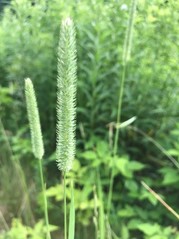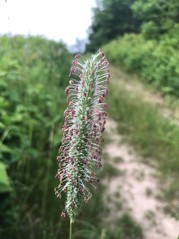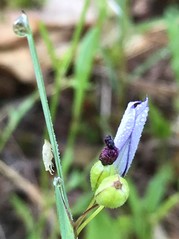 Amber Waves of Grain: Grasses
It is hard to imagine a world without grasses. Pause here and reflect on how grasses benefit you. Can you name at least five ways? Keep pondering as you read on.
Grasses are easy to take for granted. We run over, walk by, spread picnics over, put out the livestock to feed on, and mow, mow, mow them. Many people only know the grasses of their lawns and have never seen mature grasses flower and go to seed.

Meadows with uncut grasses and wildflowers are enchanting places filled with an abundance of life. One of the best ways I've found to observe a meadow is to find a place just to sit or lie back among the grasses. Watch how they sway in the wind, observe the insects that come to forage, the birds that fly by or into the grasses. Notice the temperature at ground level as you settle in for a bit of quiet observation. After you've taken some time to just enjoy being among the grasses take out a sketch pad or your camera and document what you see.
Compare the first two photos of grasses; they are the same kind of grass but one is in bloom. Can you tell if this is meadow foxtail or maybe a timothy grass? Use this grass guide from the University of Maine Cooperative Extension to help you decide.
|
- Why is it hard to tell what kind of grass this is?
- What other information do you need?
When you draw or photograph grasses be sure to record the:
- Flower details - including shape and color. Does it flower from all sides, or just on one side of the stem?
- Stem details - including length, any nodes and their color.
- Leaf details - including if they wrap the stem, and if there is a ligule - a thin strap-shaped leaf membrane or scale where the leaf meets the stem.
|
|
 |
Two grasses showing diversity of bloom/seed head types: one a loose spray, the other one-sided like an orchard grass.

Interesting Facts
- Blue-eyed grass is not a grass as all but a kind of iris. See the photo of the the blue-eyed grass with the one furled purple-blue bloom. The bloom opens in the morning and closes in the afternoon. When you look at on open bloom look for the beautiful yellow center.
- Grasslands are efficient at cooling ground temperatures at the beginning of a heatwave because soil moisture evaporates fairly quickly. However, once the soil moisture is lost, the grassland will heat up rapidly. In comparison, while forests do not provide quick cooling - soil moisture is not released as quickly as in grasslands, and trees also conserve their own water and water use by closing their stomates, forests have a long-term cooling effect during heatwaves.
- Lawn mowing, with gasoline mowers, in America contributes to 5% of our air pollution. "A conventional gas powered lawn mower spews nearly 90 pounds of the greenhouse gas CO2, and over 50 pounds of other pollutants into our air every year." (Source: EPA) Additionally the sound from the mowers contributes to sound pollution and the hearing loss of mower operators who do not wear adequate ear protection.
|
Activities for Children and the Young at Heart
- Explore a meadow. How many different kinds of grasses can you find? While you are exploring be vary careful not to disturb ground nesting birds. Be watchful for the bobolink, that flies in from thousands of miles to our south to nest in meadows.
- Learn about and visit a tall grass meadow.
- Design a meadow for your yard, then consider planting it. Here are meadow planting tips from the Wild Seed Project.
- If you have a lawn that you mow with a gas-powered lawn mower, consider getting a manual/push mower or an electric mower. This article may inspire you to make the change. Just think about how much more fresh air and quiet time you and your neighbors would have if they all used manual or electric mowers!
- Make a list of all the ways you benefit from grasses. Hints: Do any of your favorite breakfast foods originate from grasses? Do you play any sports that rely on grasses for the sports field? Do you have any animals that are grass-eaters, or enjoy any wild animals that forage on grasses and other meadow plants?
- Draw a food web based on your list from number 5.
Share Nature Note with your friends, family, teachers, scouts, and anyone you think might be interested. Here is how they can sign up for a free subscription:
Read back issues online.
Suggest a topic by email; put Nature Note in Subject line and email Jocelyn Hubbell.
|